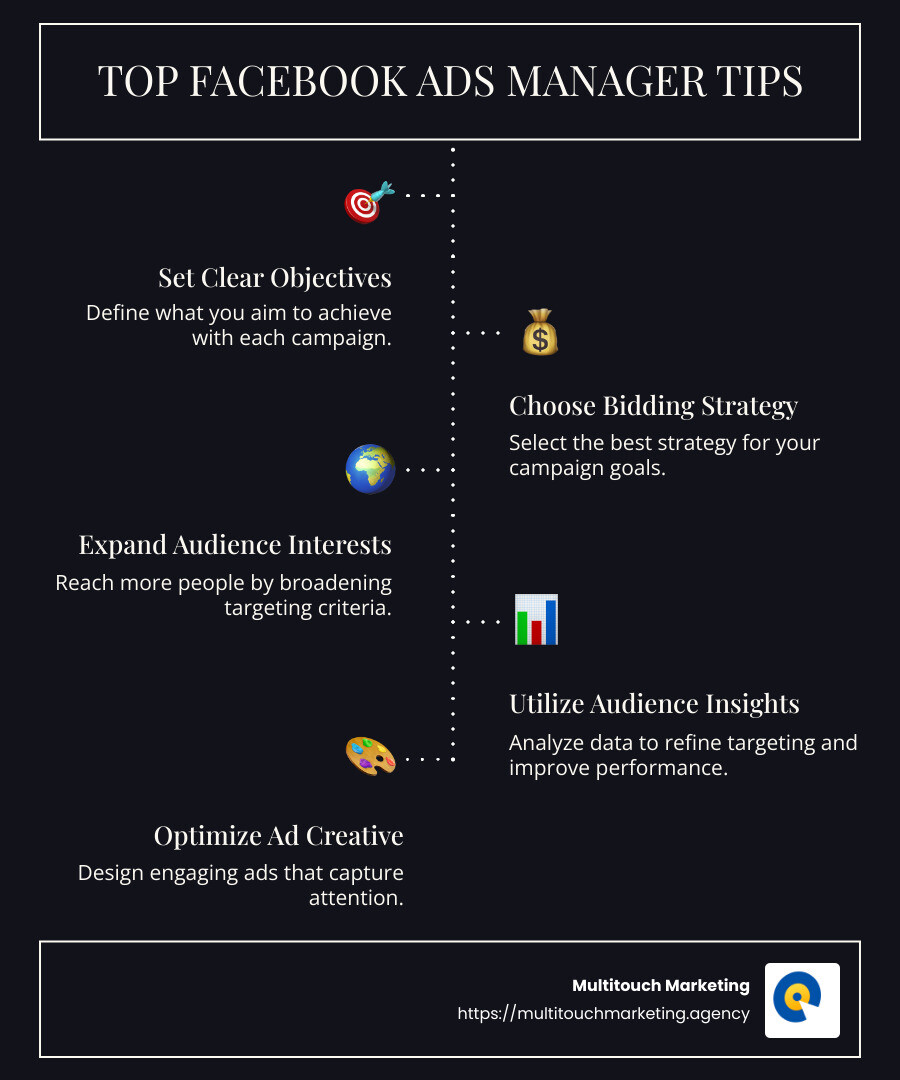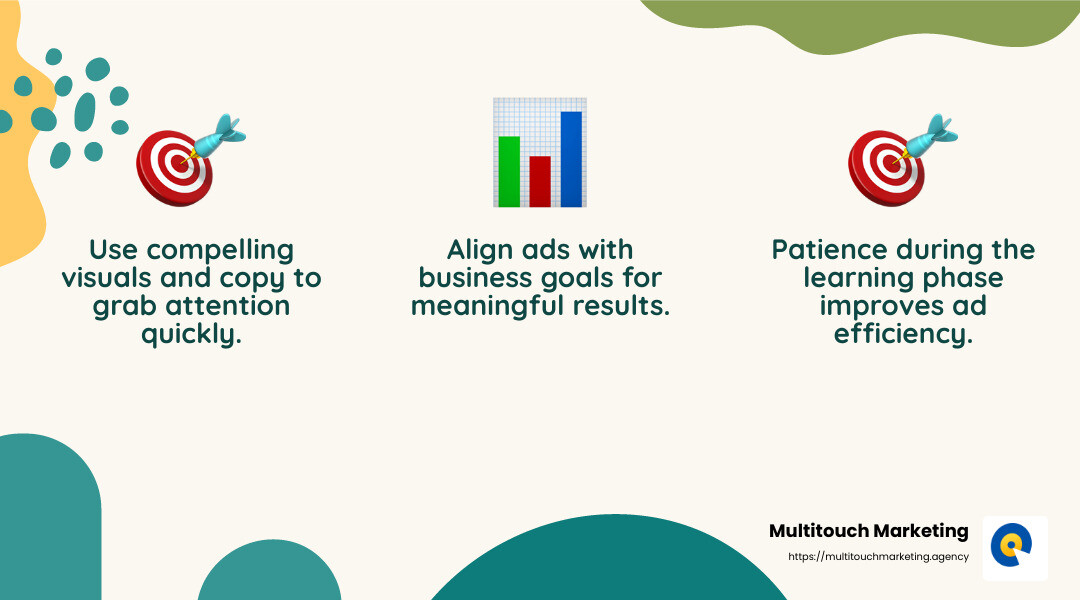Facebook Ads Manager Tips: 5 Powerful Success Secrets
Facebook ads manager tips are the key to scaling your small business in a competitive digital world. With the vast landscape of social media advertising at your fingertips, understanding and utilizing the Facebook Ads Manager effectively can transform your approach to online marketing. Here are some actionable tips to get started:
- Set clear campaign objectives
- Choose the right bidding strategy
- Expand your audience interests
Facebook Ads Manager isn’t just another tool; it’s a powerful platform that can significantly improve your online presence and sales. From choosing the right bidding strategy to defining your campaign objectives, every little detail counts towards achieving success.
I’m Milton Brown, a digital marketing expert with experience in facebook ads manager tips and strategies. With experience in paid media management, I have honed my skills to help businesses like yours achieve outstanding results in the digital space.
Quick facebook ads manager tips terms:
Understanding Facebook Ads Manager
Navigating Facebook Ads Manager can seem daunting at first, but mastering its interface and features is essential for successful ad campaigns. Let’s break it down into simple steps.
Interface Overview
The Facebook Ads Manager interface is your control center for ad campaigns. It features a dashboard that shows all your active and inactive campaigns, ad sets, and individual ads.
- Campaigns Tab: This is where you start. It gives you a bird’s-eye view of all your ad campaigns. You can create new campaigns or manage existing ones.
- Ad Sets Tab: Here, you can fine-tune your targeting, budget, and schedule for each campaign.
- Ads Tab: This is where you design the creative aspects of your ads, like images and text.
Each tab has filters and search options to help you quickly find specific campaigns or ads. This structure makes it easier to manage multiple campaigns simultaneously.
Key Features
Facebook Ads Manager is packed with features that help optimize your ad performance. Some of the most important ones include:
- Audience Insights: This tool provides detailed information about your audience’s demographics, interests, and behaviors. It helps you tailor your ads to reach the right people.
- A/B Testing: Also known as split testing, it allows you to test different versions of your ads to see which performs better.
- Conversion Tracking: By setting up conversion tracking, you can measure the actions users take after clicking your ad, like purchases or sign-ups.
Navigating the Platform
To get started, log in to your Facebook account and access the Ads Manager through the menu. Here are some navigation tips:
- Dashboard: Your starting point for an overview of all campaigns. Use the drop-down menus to filter by date or campaign type.
- Create Button: Located at the top right, this button lets you start a new campaign. Follow the guided steps to set your objective, audience, and budget.
- Reports: Use the Reports tab to view detailed analytics on your ad performance. Customize these reports to focus on metrics that matter to your business.
With practice, navigating the Facebook Ads Manager becomes intuitive, allowing you to focus more on strategy and less on logistics. As you explore its features, you’ll find that this tool is indispensable for running effective ad campaigns.
Next, we’ll dive into some best practices for Facebook Ads to further improve your campaigns.
Facebook Ads Manager Tips
To harness the power of Facebook Ads Manager, you need to approach it with a strategic mindset. Let’s explore some facebook ads manager tips that can lift your advertising game.
Ad Preparation
Before launching any campaign, preparation is key. Start by defining clear objectives. Are you aiming for brand awareness, lead generation, or direct sales? Knowing your goal will guide every decision you make.
Once your objectives are set, think about the creative elements. Use engaging visuals and compelling copy. People scroll quickly, so your ads need to grab attention fast. Test different versions to see what resonates best with your audience.
Learning Phase
When you launch a new campaign, it enters the “learning phase.” This is when Facebook’s algorithm gathers data to optimize your ad delivery. During this time, avoid making major changes to your ads. Changes can reset the learning phase, delaying optimization.
Patience is crucial here. Allow the algorithm to learn from audience interactions. Once out of the learning phase, your ads will perform more efficiently, reaching the right people at the right time.
Business Objectives
Aligning your ads with your business objectives is crucial. Facebook offers various campaign objectives, like traffic, engagement, and conversions. Choose the one that aligns with your broader business goals.
For instance, if your goal is to increase online sales, focus on conversion campaigns. If you’re looking to build brand awareness, opt for reach or engagement objectives. This alignment ensures that your ad spend is directed towards achieving meaningful results.
Audience Insights
Understanding your audience is at the heart of successful advertising. Use Facebook’s Audience Insights to learn more about your potential customers. This tool provides data on demographics, interests, and behaviors.
With this information, you can create highly targeted ads that speak directly to your audience’s needs and preferences. The more you know about your audience, the better you can tailor your messaging and creative assets.
By focusing on these areas—ad preparation, learning phase, business objectives, and audience insights—you can create effective Facebook ad campaigns that drive real results.
Next, we’ll explore some best practices for Facebook Ads to further improve your campaigns.
Best Practices for Facebook Ads
To make the most of your Facebook ad campaigns, it’s crucial to follow some proven strategies. Let’s explore key areas like objective alignment, placement optimization, budget optimization, and ad creative that can significantly boost your results.
Objective Alignment
Setting the right objectives is the foundation of any successful Facebook ad campaign. Facebook offers a variety of objectives, such as brand awareness, engagement, and conversions. According to Facebook, choosing an objective that aligns with your business goals is essential. For example, if your aim is to increase online purchases, select a conversion objective. This ensures that your ads are optimized to meet your specific goals, leading to higher ROI.
Placement Optimization
Where your ads appear is just as important as the content within them. Facebook suggests using automatic placements to let its algorithm optimize where your ads will perform best. This includes platforms like Instagram, Messenger, and Audience Network. By utilizing placement optimization, you allow Facebook to gather more data and improve ad performance. However, if you notice certain placements outperform others, consider using manual placements to focus your resources on those high-performing areas.
Budget Optimization
Effective budget management can make or break your ad campaign. Facebook’s campaign budget optimization feature allows you to distribute your budget across ad sets for the best performance. This takes the guesswork out of budget allocation and lets Facebook optimize delivery automatically. If you’re looking to maximize your return on ad spend (ROAS), consider experimenting with different bid strategies like Cost Cap or Minimum ROAS to control your ad spend more effectively.
Ad Creative
Your ad’s visual and textual elements are what capture attention. To avoid ad fatigue, regularly update your creatives with fresh images, videos, and copy. A study highlights the importance of testing different creative elements to find what resonates best with your audience. Also, incorporating a clear call-to-action (CTA) can guide users towards the desired action, whether it’s a purchase, sign-up, or visit to your website.
By focusing on these best practices—objective alignment, placement optimization, budget optimization, and ad creative—you can create more effective Facebook ad campaigns that drive meaningful results.
Next, we’ll dive into advanced strategies for Facebook Ads to take your campaigns to the next level.
Advanced Strategies for Facebook Ads
Taking your Facebook ad campaigns to the next level requires more than just the basics. Here are some advanced strategies to consider:
Content Marketing
Using content marketing in your Facebook ads can create a deeper connection with your audience. By sharing valuable and relevant content, you can engage users and build trust. For example, share blog posts, infographics, or customer testimonials that highlight your brand’s strengths. This approach not only attracts potential customers but also nurtures them through the buying journey. Content should be engaging and encourage interaction to maximize its impact.
Influencer Collaboration
Collaborating with influencers can amplify your reach and credibility. Influencers already have a dedicated following that trusts their recommendations. By partnering with them, you can introduce your brand to a wider audience. Choose influencers whose values align with your brand to ensure authenticity. This strategy can lead to increased brand awareness and potentially higher conversion rates, as followers are more likely to trust a familiar face.
Video Ads
Video content is king on Facebook, capturing more attention than static images. According to research, videos have high engagement rates and are more likely to be shared. Keep your videos short and to the point, ideally under 15 seconds, to maintain viewer interest. Adding captions can also improve accessibility and retention. Use video ads to tell your brand’s story, showcase products, or explain complex concepts in an engaging way.
Lead Ads
Facebook lead ads are designed to collect user information without them having to leave the platform. This makes it easier for potential customers to sign up for newsletters, request quotes, or download resources. Lead ads are particularly useful for gathering contact information for follow-up marketing efforts. Ensure that your lead form is simple and straightforward, and offer a compelling reason for users to share their details, such as exclusive content or discounts.
By implementing these advanced strategies—content marketing, influencer collaboration, video ads, and lead ads—you can improve your Facebook ad campaigns and achieve better results. These tactics not only improve engagement but also help in building a loyal customer base.
Next, we’ll address some frequently asked questions about using Facebook Ads Manager effectively.
Frequently Asked Questions about Facebook Ads Manager
How to use Facebook Ads Manager effectively?
To make the most of Facebook Ads Manager, understand some key concepts. Start by familiarizing yourself with the platform’s features and navigation. Audience Insights is a powerful tool that can help you identify and target the right audience. Use it to tailor your ads to specific demographics, interests, and behaviors.
When setting up your campaigns, focus on defining clear business objectives. Whether it’s brand awareness, engagement, or conversions, aligning your ad goals with your business strategy is crucial. This ensures that your campaigns are not only effective but also measurable.
What is the best strategy for Facebook ads?
A successful Facebook ad strategy often hinges on budget allocation and testing. Allocate your budget wisely by starting with a modest amount and gradually increasing it as you identify what works best. This approach helps in minimizing risk while maximizing return on investment.
A/B testing is another essential component. It involves creating different versions of your ads to see which performs better. Test various elements such as images, headlines, and calls-to-action to find the most effective combination. Keep your tests structured and avoid making too many changes at once to ensure clear results.
What is the 20% rule on Facebook ads?
The infamous 20% text rule once limited the amount of text you could include on Facebook ad images. While this rule is no longer strictly enforced, it’s still a good practice to keep text minimal. Facebook favors ads with less text, as they tend to perform better in terms of engagement and reach.
If your ad gets rejected, it might be due to excessive text or other guideline violations. Ensure your text is concise and directly related to the ad’s content. Use Facebook’s built-in grid tool to check if your ad complies with their text guidelines before submission. Keeping text minimal not only aligns with Facebook’s preferences but also improves the visual appeal of your ads.
By understanding these frequently asked questions and incorporating these facebook ads manager tips, you’ll be better equipped to steer the platform and optimize your advertising efforts.
Next Steps
Navigating Facebook advertising can be a daunting task, but with the right guidance, it becomes a powerful tool for business growth. At Multitouch Marketing, we specialize in helping businesses open up the full potential of Facebook Ads Manager. Our expertise in PPC campaigns ensures that your ad strategy is not only effective but also aligned with your business goals.
We understand the complexities of digital marketing, and our team is here to provide expert guidance every step of the way. From setting up your ad account to optimizing your campaigns, we offer custom solutions that drive results. Our approach focuses on leveraging audience insights and strategic budget allocation, ensuring you get the best return on your investment.
With our offices located in Raleigh, NC, we’re committed to supporting businesses in their quest for online success. Whether you’re new to Facebook advertising or looking to refine your strategy, we’re here to help you achieve your objectives.
For more insights on how we can improve your social media advertising efforts, explore our advantages of social media advertising page. Let us help you transform your Facebook advertising into a powerful engine for growth.




